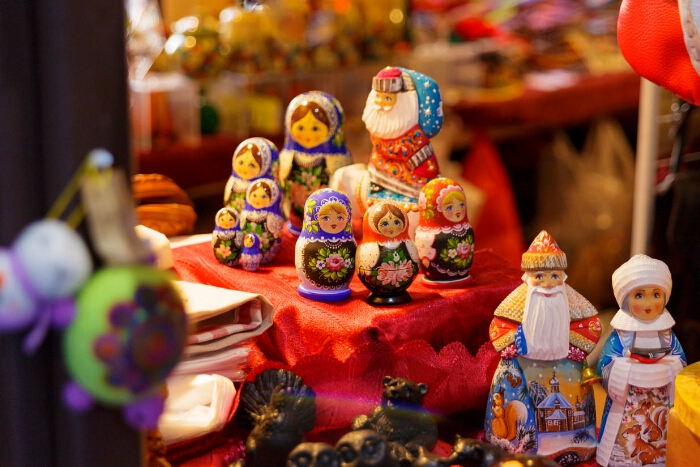Nested dolls from the village of Polkhovsky Maidan are famous for their “rose-colored” drawings. The multi-petal flower of wild rose is the main element of the ornament. Preliminary drawing of black contours of the pattern is done with ink and pen. Paint the nesting dolls with bright aniline dyes by applying one color to another.
Only three colors are used: Scarlet, yellow, blue, but purple and green are obtained by imposing. The nested doll has no such details as hands, a scarf, a sundress, and a jacket, characteristic of other dolls. The face is framed by “curls”, a genuine detail of an old local dress. The women tucked their hair under the headdress, the girls under the ribbons, and around the face in the headdress stuck “curls”: black curled feathers of the drake. This interesting household detail was preserved by the masters in the nesting dolls painting. When you think about how much Russian nesting doll is worth then you will have to go for the following information.

Vyatskaya Nesting Dolls
Vyatka nesting dolls is the most complex in manufacturing technology. The Vyatka painted wooden doll acquired uniqueness and a special originality when the nesting dolls was not only painted with aniline dyes, but also inlaid with specially grown rye straws. Vyatka has long been famous for its products from birch bark and bastards, in which besides skillful weaving techniques, an embossed pattern was used, and so straw inlay was used at the end of the last century as a new way of decorating the nesting dolls. Vyatka nesting dolls from the village lady in a headscarf was transformed into a mysterious northern beauty.
Modern Dolls
Nesting dolls today is one of the most famous souvenirs associated only with Russia. It is believed that this painted wooden doll is almost the perfect embodiment of Russian culture. However, this symbol of the Russian soul is not only an original Russian work of art, but also generally appeared in Russian culture relatively recently. Russian dolls are historic and cool but modern action figures is the new thing. For a perfect gift or souvenir of nesting dolls to that special someone check out Nestingdolls co, and also, be sure to know the the rules of gift giving.
The First Mother
The first mother made in Russia at the turn of the XIX and XX centuries, and its prototype served as a Japanese wooden figurine, depicting one of the heroes of Japanese folk art. It is not known for certain who exactly was depicted on the figure with which the image of the nesting dolls was copied. According to one version, it was the statuette of the elder Fukurum, on the other it was the god of wealth Fukurokuju, according to the third, it was a figure of Daruma, according to the fourth, this was Kokesi’s doll.
According to one of the versions in one of the evenings of 1890, the owner of the estate in Abramtseve, situated near Moscow, presented her guests the artistic elite a fun toy. On the eve she brought a figure from Japan: inside the god Fukurum hid another four.
Fukuruma
Detachable toy interested artist Sergei Malyutin, and he decided to do something similar. He did not, of course, repeat the Japanese deity, made a sketch of a round-faced peasant woman in a flowered shawl. And to make her look better, he would draw a black rooster into her hand. The next lady was holding a sickle. Another one is a loaf. The whole family is friendly and hardworking. When the turner made it, and the artist painted it, then the name came of itself Matrona.

So, again, according to one of the versions, the deity of the Japanese pantheon Fukurum became the ancestor of the world famous Russian toy – nesting dolls. Ten years later, as an original craft from Russia, it was awarded the gold medal of the World Exhibition in Paris. And today, few people remember its Japanese origin and the Nesting dolls are considered to be a primordially Russian brand.
Separate Area
This is a separate area of ??artistic art. Products created by famous masters are shown at international exhibitions and festivals they are hunted by collectors, private and public museums. Many of them have a great educational value, and give us the opportunity to learn more about the life and life of different nations. The main task of the artists in this case is to convey as accurately as possible the features of the historical era to which the character belongs. A separate direction is the author’s doll, where the author’s imagination is not limited by anything.
How did the dolls appear?
The first toys depicting animals, birds and people appeared in prehistoric times. Of course, these items can be called so called with a great stretch such figures are more often used for rites and spells than for playing. Dolls in the modern sense appeared in the middle Ages and were first made from porcelain. They were quite expensive, and even royal children could not play with them every day.
Until the 18th century, most of the dolls in Russia were wooden or rag. Toys were sewn from the remnants of matter and stuffed with hay, leaves, straw or feathers. These products are the prototype of the modern dolls that kids like, which allows us to touch the long past era. In the 19th century in Russia there are factories specializing, including the production of toys. New materials – papier-mâché, composites gradually replaced the paper, wood and fabrics. After the revolution, until about the 40s, only cellulose products were produced, and then they were replaced by “pups” and plastic toys from the times of stagnation. Interest in dolls as a work of art and a collectible was revived only after perestroika. Now we know that nesting dolls originated from Russia. Mexico also have an infamous creepy tourist attraction called island of dolls.
